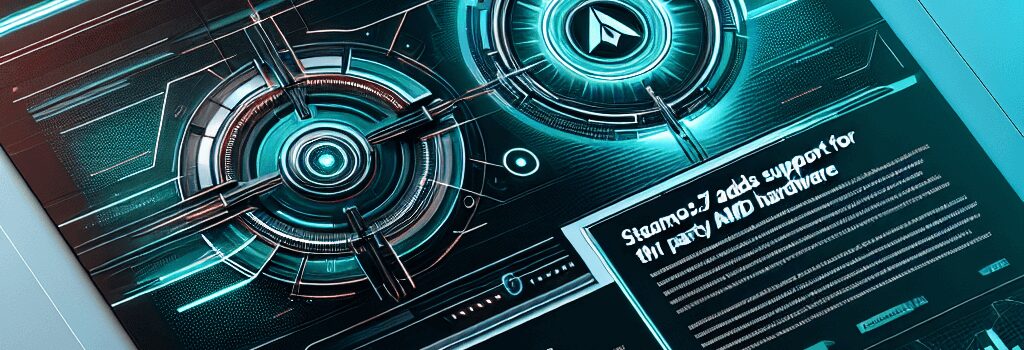SteamOS 3.7 Adds Support for Third-Party AMD Hardware

Valve has just pushed out SteamOS 3.7.8 to the public, marking a pivotal shift in its ambitions to bring a console-style Linux gaming OS to a broader range of systems. For the first time since the launch of the Steam Deck, Valve is offering official and improved support for select AMD-powered handheld PCs and generic desktops, paving the way for enthusiasts and OEMs alike to adopt SteamOS as a dedicated gaming platform.
New Hardware Support
This release highlights compatibility with several high-profile handhelds and laptops:
- Asus ROG Ally (Ryzen Z1 Extreme): Improved controller mapping, thermal profiles, and docked mode support.
- Lenovo Legion Go & Legion Go S (Ryzen Z1/Z2): Official images for the Legion Go S, and community-certified instructions for the original Go.
- Other AMD Ryzen Z1/Z2 handhelds: Valve claims broad baseline support for any third-party device built around AMD’s latest handheld APUs.
Beyond handhelds, all-AMD desktops and laptops—incorporating Ryzen 5000/7000 series CPUs, Radeon graphics, and the accompanying AMD X670 or B650 chipsets—are now eligible for a full SteamOS experience.
Installation Requirements
- AMD hardware (CPU, GPU, chipset) and compatible RZ Wi-Fi/Bluetooth module.
- NVMe SSD with at least 64 GB of capacity.
- Disabled Secure Boot in UEFI settings (required to load unsigned Linux kernels).
Valve provides a step-by-step guide using Rufus (Windows) or Balena Etcher (macOS/Linux) to flash the recovery image onto a USB drive. After rebooting into the installer, users can repartition their drive to replace existing OS installations. Note that dual-boot configurations are not officially supported: reverting to Windows requires re-enabling Secure Boot and a fresh Windows USB installer.
Under the Hood Improvements
SteamOS 3.7.8 brings several key software updates:
- Linux kernel 6.11 – Improves AMD Ryzen power management, adds better CPU frequency governors, and includes the Zstd-compressed kernel image for faster boot times.
- Plasma 6.2.5 – Offers smooth desktop mode transitions, improved low-battery notifications, and Wayland session stability fixes.
- Mesa 23.3 – Upgraded Mesa drivers with Radeon RADV Vulkan performance boosts (+15 % in some titles) and RDNA 2 shader compiler optimizations.
- Arch Linux base update – Incorporates the latest pacman, systemd v255, and updated firmware blobs for AMD’s OOB firmware updates.
- Security patches across SSH, OpenSSL, and the Linux crypto API to mitigate spectre/meltdown variant attacks.
Developer Perspective: Driver Ecosystem and Kernel Roadmap
Industry experts note that Valve’s switch to kernel 6.11 unlocks long-term benefits:
“With Zen 4 support maturing and AMD’s open-source GPU drivers now on par with proprietary alternatives, SteamOS is positioned for lower-level optimizations that we’ll see in Proton 9 later this year,” says Jonathan Carter, a Linux kernel contributor. “Valve’s close collaboration with AMD helps ensure new CPU P-state drivers and improved GPU power capping land first in SteamOS.”
Security and Modularization
SteamOS 3.7 refines its secure-boot-less deployment model by integrating a signed shim loader and providing scripts to enroll custom keys in UEFI. The OS now uses a modular Btrfs root filesystem with snapshot support via Snapper, enabling atomic updates and rollback capabilities—an enterprise-grade feature now accessible to gamers.
Future Outlook: Cloud Gaming and Beyond
With Microsoft Azure and AWS rolling out AMD-powered GPU instances (e.g., AMD MI300 accelerators) for cloud gaming, SteamOS could become the default thin-client OS for local edge streaming. Valve’s recent “SteamOS Compatible” label augurs further integration with cloud APIs and opens the door for SteamLink enhancements on non-Valve hardware.
Conclusion
SteamOS 3.7 represents Valve’s most ambitious push yet to decouple its gaming ecosystem from the Steam Deck. By embracing third-party AMD hardware, improving low-level drivers, and bolstering security, Valve is laying the groundwork for an open, Linux-first gaming future. While Windows remains the general-purpose desktop OS, dedicated gaming rigs—especially portable handhelds—now have a compelling alternative that’s continuously optimized at the kernel and driver level.
Greetings! I know this is kinda off topic but I was wondering if you knew where I could locate a captcha plugin for my comment form?
I’m using the same blog platform as yours and I’m having difficulty finding one?
Thanks a lot!